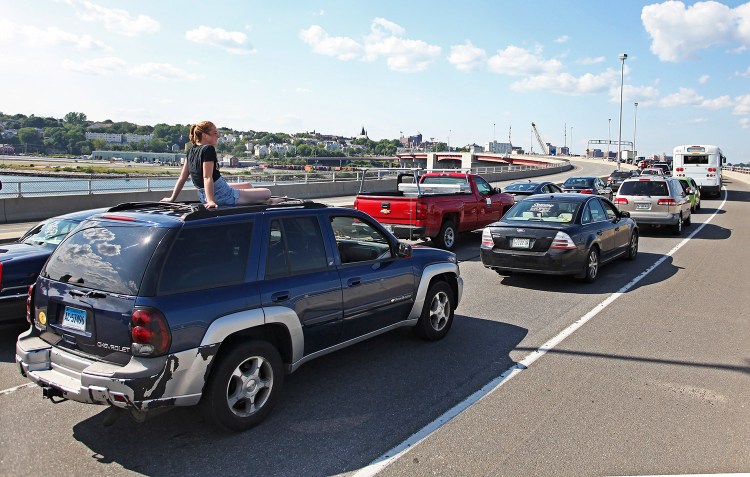The Maine Department of Transportation will do a full analysis to gauge the life span of mechanical and electrical systems on the Casco Bay Bridge.
The intent is to identify which components are nearing the end of useful life and replace them before they cause problems, like the malfunction of a nearly $7,500 processor unit that created a massive traffic jam in Portland and South Portland late Monday afternoon.
“We want to be proactive, we want to stay in front of this, and all of our efforts are pointed in that direction,” said transportation department spokesman Ted Talbot.
An overall systems analysis was planned after a 2016 mechanical and electrical inspection, Talbot said.
He noted that the bridge is almost 20 years old, and “we are looking to update” its electrical components and systems.
“There are pieces of tech in there that are rapidly becoming obsolete,” Talbot said.
Monday’s traffic backup was caused when a computer processor failed, cutting power to gates that are lifted to let traffic move again after a ship has passed under the bridge. Technicians found the problem and replaced the processor within an hour, but the magnitude of the traffic jam forced police to close the bridge and detour vehicles, Talbot said. The bridge between Portland and South Portland over the Fore River carries about 32,00 vehicles a day.
The latest equipment problem followed two gate malfunctions that created more traffic problems just days earlier. Those problems occurred when locking mechanisms on the gates failed and were not related to Monday’s problem, Talbot said.
In March, the bridge was closed when the southbound drawbridge section was stuck in the raised position, because of an electrical problem.
The frequency of malfunctions has led some to wonder if they are linked to the 2015 decision to outsource bridge operations to Florida Drawbridges Inc., also called FDI Services, a contractor that operates and maintains movable bridges for six states and the District of Columbia.
Maine signed a five-year, $3.8 million contract with the company in December 2015, saying that it would not save money, but would free up the nine state employees to work on other road and bridge projects. The deal was criticized by some state lawmakers and the state employees’ union.
Michael Erard, who was stuck in the bridge traffic Monday afternoon, also wondered if recent problems were linked to hiring a private firm.
“I would note that as soon as the Department of Transportation cedes some part of the control to someone else, these things start to occur,” Erard said in an interview Tuesday.
Erard was returning to his home in Willard Square in South Portland after picking his son up at summer camp when he got trapped on the bridge, a route he takes two or three times a day. Instead of the normal 10-minute drive home once he hits the bridge in Portland, it took him an hour and a half to detour onto Interstate 295 and through heavy traffic in South Portland and Scarborough.
“When that bridge goes, it screws up traffic for a huge radius,” Erard said. “No one is calculating the dollar value of the time for thousands of people stuck in traffic.”
State transportation officials sympathize with drivers’ frustration, but say that switching management to FDI Services is unrelated to the recent equipment malfunctions.
“These are technical issues that have nothing to do with bridge tendering,” said John Buxton, the department’s senior bridge engineer. “Anything that big, with that many components, pieces wear out, we have to change them when we can.”
It will cost about $10,000 to replace and install the processor unit that failed Monday and buy a new component for reserve in case it happens again.
The 2016 mechanical inspection showed that all the systems were solid, but the department opted to conduct a more thorough analysis to determine the life span of components and come up with a replacement plan, Buxton said.
Generally, the Casco Bay Bridge is in good structural shape. The most recent inspection report, from 2015, scored the deck and substructure as “very good,” while the superstructure received a “good” score.
The bridge is operated by two FDI Services employees and is overseen by a Department of Transportation supervisor. There are monthly safety inspections, but occasionally unanticipated problems crop up, especially with traffic gates, which are extremely sensitive and easily malfunction, Buxton said.
“For some reason gates are the Achilles’ heel for movable bridges,” he said. “It doesn’t take a lot to cause you some problems.”
Send questions/comments to the editors.



